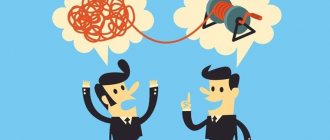The human brain is designed in such a way as to save as much energy as possible in the body in case of life-threatening situations. We no longer need to escape from predators, hunt mammoths and fight with other tribes. But, despite many centuries of evolution, one of the main tasks of the brain remains the ergonomic expenditure of energy on any processes not directly related to ensuring the vital functions of the body. He is helped in this by cognitive distortions, the purpose of which is to prevent us from deviating from familiar and proven patterns and algorithms of action.
To understand how to properly work with cognitive distortions, you need to understand each of them in detail. We have already discussed some of it in the article “7 cognitive distortions that prevent you from making the right decisions.” Today we’ll add one more thing to this collection, thanks to which we often come to the wrong conclusions and, as a result, make mistakes. It's called survivorship bias.
The emergence of survivor bias
During the Second World War, one of the most important tasks set by the command of the US armed forces was to reduce the number of downed bomber aircraft. Not all American planes managed to return after the shelling, and those that returned had holes from shots.
It would seem that the solution to the problem lies on the surface: strengthen the aircraft with additional armor. However, the difficulty was that solid armor for fighters was excluded because they became too heavy. The engineers faced a question: which part should be reinforced with additional armor?
A solution to the problem was found by the Hungarian mathematician and statistician Abraham Wald, who, contrary to the popular belief that it is necessary to strengthen the places with the largest number of bullet holes (along the wings, near the tail gunner and in the center of the lower part of the hull), proposed strengthen those parts where there were no bullet holes at all or very few (fuel system and engine). He stated that conclusions must be drawn from downed aircraft and that the undamaged areas of bombers are also their most vulnerable areas. It was precisely because they were not hit that the planes were able to return to base.
The US command decided to follow Wald's advice and reinforced with additional armor the places that had the least bullet marks. Thanks to this decision, the number of aircraft lost as a result of shelling was significantly reduced.
The desire to draw conclusions based only on data on surviving aircraft, without taking into account unfortunate statistics, almost led the US military to significant losses and was later called “Survivor Bias”.
Where we encounter this: examples in life and business
People are subject to this cognitive bias in different situations: when making decisions in everyday life, financial planning, in scientific research, in business.
How it all began: downed planes of World War II
A textbook example of the “survivor's fallacy” is the discovery of mathematician Abraham Wald during World War II. The American army lost many aircraft in battle. To solve the problem and reduce losses, the command set Wald a task: to figure out how to strengthen the structure. It was impossible to fully book the vehicles, otherwise they simply would not have flown, so it was necessary to determine the most vulnerable spots.
Military engineers studied the damage to vehicles returning from the battlefield and suggested that the most damaged parts needed to be strengthened. However, Abraham Wald noted that if the plane was able to return to base, then the hits to these units were not critical. It is more important to pay attention to the damage with which the planes did not return. That is, you need to reserve those places where the “surviving” vehicles did not have holes. This helped reduce American aviation losses and save the lives of many pilots.
“Survivor's error” today: how it manifests itself in everyday life
- If a plane crashed somewhere or doctors made a mistake that led to death, then an article about it appears in the media. Although, according to statistics, most planes land successfully, and doctors more often take the right actions, the news is driven mainly by negative stories. Because of this bias, some people have the impression that flying is dangerous and all doctors are incompetent.
- The belief that dolphins save people is another example of the “survivor fallacy.” There are cases when they actually helped drowning people get to shore. Such stories end up in the media and create the impression that dolphins are rescuers. In fact, these mammals can exhibit aggressive behavior towards people, causing serious injury and even drowning. Those who are lucky talk about miraculous rescues, but those who became victims of dolphins will not tell anything for obvious reasons.
- Survivor bias is also found in medical research. For example, when scientists determine survival rates for a disease, only those patients who have already been diagnosed are included in the statistics. Those patients who die before diagnosis are not included in the sample. This leads to distortion of real results.
Dmitry Kovpak, psychotherapist, candidate of medical sciences, associate professor of the department of psychotherapy, medical psychology and sexology of the North-Western State Medical University. I. I. Mechnikova, President of the Association of Cognitive Behavioral Psychotherapy:
×
“The pandemic clearly shows how the “survivor bias” distorts perception and what it leads to. People believed in conspiracies of governments and transnational corporations, put forward conspiracy theories of what was happening, and in some countries everything reached the point of absurdity: citizens who denied the existence of the new coronavirus leading to the disease COVID-19 demonstratively licked door handles just to show that this virus did not exist. exists. And if they did not become infected after this, they presented it as proof of their theory. Other people looked at all this and believed that the virus really did not exist. And then they ended up in hospitals.
In this case, the “survivor’s mistake” is dangerous and painful. Because when a person believes there is no problem and then comes face to face with it, it becomes a double whammy. In addition to the fact that he finds himself in a difficult life situation, he is also amazed that something happened that simply could not have happened in his picture of the world. Such serious crises can form post-traumatic disorders, a crisis of trust in oneself and the world, learned helplessness and depression.”
The “Survivor's Fallacy” in Business: How It Affects Decision Making
The “survivor fallacy” is common in business. Nobody talks about companies that failed early and no longer exist, but the successes of a few dozen have been praised for decades. This skews the statistics and convinces many that a positive outcome is more likely than it actually is. For example, despite the fact that according to statistics, 90% of startups fail, aspiring entrepreneurs are confident that they can be among the winners.
Other people's success stories and career strategy
A prime example of the “survivor fallacy” is the cult of success stories. Many people take inspiration from stories of billionaire entrepreneurs and misunderstand cause and effect. For example: “Steve Jobs dropped out of college and became a millionaire. So, the secret to success is to leave the university and devote all your time to your idea.” In reality, this doesn't work, and billionaires without a college degree are rarer than they seem: of the 362 richest people in America, only 12.2% dropped out of college.
Those who seek to replicate the success story of a company or individual often ignore the role of time, luck, connections and socio-economic background. Many famous entrepreneurs have achieved success despite their unusual choices, not because of them.
What is survivorship bias?
Survivorship bias is a type of cognitive trap that distorts statistical data. It is very easy to fall into this trap: it is enough to draw one-sided conclusions without taking into account the whole picture. This error is made when, when selecting information, statistics on a group of successful cases are used, i.e. “survivors”, but data from the “dead” group is not used at all.
The whole essence of the systematic survivor error comes down to one thing: from a large group of identical objects (for example, airplanes), we take only one part of them (in our case, the survivors), identify common characteristics and properties (places vulnerable to shelling) and then distribute these properties for the entire group (where to install additional armor). If you do not take into account the second part of the objects (the planes that did not return to base), you can make a fatal mistake, which the US command almost made at one time.
This error occurs not only in this example, but awaits us at almost every step. Let's look at it with other examples.
Two quotes, a sentence and a symbol
The meaning of life is those goals that make you value it.
Believe that life is worth living and your faith will help you create something worth living for.
William James, philosopher and psychologist, author of Pragmatism: A New Name for Old Ways of Thinking (1907) and many other works. Free translation.
Suggestion : When making an important decision, remember the approach of the mathematician Wald. Perhaps this will help avoid that same systematic error.
Symbol : the work is called The Road. Perhaps this is a symbol of a difficult but personal path to a goal that fills life with meaning.
In achieving goals that are truly important to us, there is both meaning and happiness. What else?
Common Examples of Survivorship Bias
Survivorship bias is much more common in our lives than we think. Among the striking examples is the widespread popular rumor that all dolphins are kind mammals that help drowning people escape by pushing them to the shore. There is no scientific justification or support for this fact, except for the evidence and testimony of survivors. At the same time, the statistics completely lack figures about those killed as a result of the fact that dolphins pushed them from the shore. Drawing a conclusion only on the testimony of one part and extending it to the entire group is wrong. That is why the statement about the heroism and kindness of dolphins cannot be considered an axiom.
The ancient Greek poet Diagoras of Melos, who lived in the 5th century BC, came to a similar conclusion. Then the question concerned the surviving sailors, who were saved solely due to the fact that they appealed for help to the ancient Greek deities. Diagoras questioned this claim, asking if there were any references to those who prayed to the gods during the storm but never survived?
It is the absence of testimony from the dead that does not allow us to fully speak about the objectivity of the statistics. This is the essence of survivorship bias: not taking into account data from those who can no longer provide it.
Examples of this cognitive bias can be found in absolutely every field where statistics can be applied. For example:
- Medicine. The Internet is full of stories about how people independently recovered from serious and sometimes fatal illnesses using homeopathy or home medicine. At the same time, few places indicate the number of fatal diseases in people who chose this treatment method.
- Advertising. Marketers, wanting to demonstrate their product in a favorable light, cite positive statistics as an example. For example, in advertising for weight loss products you can find successful examples and reviews from satisfied customers. Advertising, naturally, is silent about unsuccessful examples of people for whom this product did not help.
- Literature. In school and student programs, only a small part of works of foreign fiction is considered. At the same time, not everyone realizes that foreign art is only a small percentage of books translated into our language. All other books remaining in the original language may not be taken into account. This also includes all the business books that teach us examples of successful people, but do not tell us about people who tried but never achieved anything.
As you and I can see, there are a huge number of examples of survivorship bias. The ability to notice it is an important step. But what can you do to avoid committing it?
Manipulations of “successful success” coaches
We constantly hear and watch successful actors, athletes, and businessmen on our screens. We want to be the same - to achieve high results, to become the best in everything.
Therefore, we carefully monitor what secrets these people reveal in their interviews. We read books about famous millionaires in the spirit of “Ten Golden Rules of Success.”
But why do we think that the rules that helped a few will work for us - millions of people? Because we make the same survivor mistake. We have heard little about the thousands of people who followed the same rules of “success” and failed. They don’t write books like “One Hundred Reasons for My Failure” or “Five Commandments for My Failure.” Hollywood doesn't make films about them.
I admit, when I talked or wrote about my successes, I also made a similar mistake. I thought: “If it worked for me, it will definitely work for you.” Although even the statement “Once I succeeded, I will succeed again” is very controversial. A large number of different unaccounted factors come into play.
Business coaches and esotericists - adherents of “universal abundance”, who have flooded the Internet and travel around the world, talk about how to become rich. And they give examples of real people who followed their advice and actually got rich. They are not lying: such people exist. But there are hundreds of times more people who followed the same advice and lost. Such manipulation may be unconscious - the guru may firmly believe in his technique and ignore negative facts.
This does not mean that in the future you should not learn anything from successful people and follow their advice. But it makes sense to include critical thinking more often and try to evaluate information more objectively.
How to avoid survivorship bias?
Survivor bias, as we found out earlier, is a fairly common phenomenon. Every person at least once in his life has encountered this cognitive distortion, since very often information is consciously or unconsciously provided only from one side.
If you do not learn to take a critical approach to the data received and analyze it correctly, you can make mistakes that will subsequently cause serious damage to a person’s property, status, health, and may even cost his life.
So how can you learn to monitor this cognitive bias?
Survivor bias is taking into account known facts and neglecting unknown but existing ones. Therefore, when analyzing information and making decisions, you need to ask yourself the following questions:
- Do I have all the information?
- Under what conditions was this data collected?
- Do I see the whole picture or only a small part of it?
- Do I pay attention to unfortunate statistics?
- What other data can I get to see the full picture?
Answering these questions helps you critically look at the data provided, look at the situation from all sides and draw a conclusion based on detailed analysis.
Our Cognitive Science program can be a huge help in this, which examines the features, nuances and various thinking techniques that allow you to avoid common and dangerous cognitive distortions.
Lies and statistics
The human brain is imperfect and can make mistakes. And sometimes, without external help, an error cannot be detected. Scientists call such quirks of thinking cognitive distortions.
Night anti-aircraft fire
A military man is also a man, and nothing human is alien to him. During World War II, several hundred specialists struggled with the problem of protecting bombers from anti-aircraft fire, and it was solved by a Hungarian statistician who worked for the Pentagon.
Mark Twain once said that there are three kinds of lies: lies, damned lies and statistics.
Only those who did not study statistics and econometrics at university laugh at this joke. Anyone who has spent nights poring over uneven columns of numbers, calling on all the gods, trying to find variance, three sigma or calculate probability distributions, treats it like black magic - complex, obscure and surprisingly dangerous in the hands of the uninitiated.
Hungarian magician
This story will focus on the magician of statistics, the Hungarian mathematician Abraham Wald.
Abraham Wald
Realizing in time that Hungary was becoming one of the Axis (Nazi bloc) countries, Wald rushed to America and quickly got a job in the Statistical Research Group. The scientists gathered in this organization calculated various questions for the military: how many machine guns should be taken for one regiment, how to bomb the enemy more effectively - by targets or by the square-cluster method, how much corn one Marine eats per year... In a word, everything that can useful to the army.
The researchers worked in Manhattan, and often got their hands on the most secret data.
The security service seriously advised Abraham Wald not to read the reports he had written, but to immediately hand it over to his superiors and run away.
After all, he’s a defector from an enemy country, and a very smart one at that. If the security guards had been given free rein, they would have removed him from work altogether under a plausible pretext, but Abraham Wald was too important and necessary a person.
To solve the problems assigned to the group, he used the method of statistical sequential analysis. This tool, still used today in econometrics, consists of several successive samples and their observations, which ultimately make it possible to assess both the completeness of the sample and the accuracy of the decision made.
That is, with the help of complex formulas, not only is the problem solved, but it is also possible to determine how clearly and fully the conditions for its implementation were taken into account.










